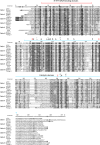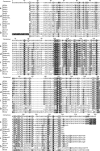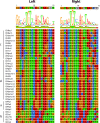An analysis of the IS 6/IS 26 family of insertion sequences: is it a single family?
- PMID: 31486766
- PMCID: PMC6807381
- DOI: 10.1099/mgen.0.000291
An analysis of the IS 6/IS 26 family of insertion sequences: is it a single family?
Abstract
The relationships within a curated set of 112 insertion sequences (ISs) currently assigned to the IS6 family, here re-named the IS6/IS26 family, in the ISFinder database were examined. The encoded DDE transposases include a helix-helix-turn-helix (H-HTH) potential DNA binding domain N-terminal to the catalytic (DDE) domain, but 10 from Clostridia include one or two additional N-terminal domains. The transposase phylogeny clearly separated 75 derived from bacteria from 37 from archaea. The longer bacterial transposases also clustered separately. The 65 shorter bacterial transposases, including Tnp26 from IS26, formed six clades but share significant conservation in the H-HTH domain and in a short extension at the N-terminus, and several amino acids in the catalytic domain are completely or highly conserved. At the outer ends of these ISs, 14 bp were strongly conserved as terminal inverted repeats (TIRs) with the first two bases (GG) and the seventh base (G) present in all except one IS. The longer bacterial transposases are only distantly related to the short bacterial transposases, with only some amino acids conserved. The TIR consensus was longer and only one IS started with GG. The 37 archaeal transposases are only distantly related to either the short or the long bacterial transposases and different residues were conserved. Their TIRs are loosely related to the bacterial TIR consensus but are longer and many do not begin with GG. As they do not fit well with most bacterial ISs, the inclusion of the archaeal ISs and the longer bacterial ISs in the IS6/IS26 family is not appropriate.
Keywords: IS26; ISFinder; insertion sequence; phylogenetic analysis.
Conflict of interest statement
The authors declare that there are no conflicts of interest.
Figures








Similar articles
-
Characterization of the specific DNA-binding properties of Tnp26, the transposase of insertion sequence IS26.J Biol Chem. 2021 Oct;297(4):101165. doi: 10.1016/j.jbc.2021.101165. Epub 2021 Sep 3. J Biol Chem. 2021. PMID: 34487761 Free PMC article.
-
An IS26 variant with enhanced activity.FEMS Microbiol Lett. 2019 Feb 1;366(3):fnz031. doi: 10.1093/femsle/fnz031. FEMS Microbiol Lett. 2019. PMID: 30753435
-
The helix-turn-helix motif of bacterial insertion sequence IS911 transposase is required for DNA binding.Nucleic Acids Res. 2004 Feb 23;32(4):1335-44. doi: 10.1093/nar/gkh276. Print 2004. Nucleic Acids Res. 2004. PMID: 14981152 Free PMC article.
-
The many faces of the helix-turn-helix domain: transcription regulation and beyond.FEMS Microbiol Rev. 2005 Apr;29(2):231-62. doi: 10.1016/j.femsre.2004.12.008. FEMS Microbiol Rev. 2005. PMID: 15808743 Review.
-
Insertion sequence diversity in archaea.Microbiol Mol Biol Rev. 2007 Mar;71(1):121-57. doi: 10.1128/MMBR.00031-06. Microbiol Mol Biol Rev. 2007. PMID: 17347521 Free PMC article. Review.
Cited by
-
Quantification of antibiotic resistance genes and mobile genetic in dairy manure.PeerJ. 2021 Dec 23;9:e12408. doi: 10.7717/peerj.12408. eCollection 2021. PeerJ. 2021. PMID: 35036113 Free PMC article.
-
Complete Genome Sequencing of Acinetobacter baumannii AC1633 and Acinetobacter nosocomialis AC1530 Unveils a Large Multidrug-Resistant Plasmid Encoding the NDM-1 and OXA-58 Carbapenemases.mSphere. 2021 Jan 27;6(1):e01076-20. doi: 10.1128/mSphere.01076-20. mSphere. 2021. PMID: 33504662 Free PMC article.
-
The IS6 family, a clinically important group of insertion sequences including IS26.Mob DNA. 2021 Mar 23;12(1):11. doi: 10.1186/s13100-021-00239-x. Mob DNA. 2021. PMID: 33757578 Free PMC article. Review.
-
Comment on "the IS6 family, a clinically important group of insertion sequences including IS26" by Varani and co-authors.Mob DNA. 2022 Jan 3;13(1):1. doi: 10.1186/s13100-021-00257-9. Mob DNA. 2022. PMID: 34980247 Free PMC article.
-
Genome Plasticity by Insertion Sequences Learned From a Case of Radiation-Resistant Bacterium Deinococcus geothermalis.Bioinform Biol Insights. 2021 Aug 4;15:11779322211037437. doi: 10.1177/11779322211037437. eCollection 2021. Bioinform Biol Insights. 2021. PMID: 34413635 Free PMC article.
References
-
- Campbell A, Berg DE, Lederberg EM, Starlinger P, Botstein D, et al. Nomenclature of transposable elements in prokaryotes. In: Shapiro JA, editor. DNA Insertion Elements, Plasmids and Episomes. Cold Spring Harbor, NY: Cold Spring Harbor Laboratory; 1977. pp. 15–22.
-
- Galas DJ, Chandler M. Bacterial insertion sequences. In: Berg DE, Howe MM, editors. Mobile DNA. Washington, DC: American Society for Microbiology; 1989. pp. 109–162.
Publication types
MeSH terms
Substances
LinkOut - more resources
Full Text Sources
Research Materials

